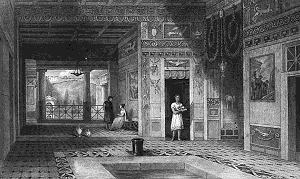Plate XXXVII - Poet's house restored
|
This restoration is calculated to afford an idea of
the pleasing effect which even a moderately sized
house, arranged in the manner of the ancients, is
capable of producing. |
The light is admitted into the nearest division of this
atrium or cavaedium through a quadrangular hole
in the roof, which inclined toward the centre, and seems to
have been called comaedium, as the opening itself was
styled compluvium, and the recipient of the water in
the pavement below the impluvium. Nevertheless these
terms seem to have often been confounded, for Plautus
mentions the seeing into an impluvium from another
house, and Terence also says, «per alienas
tegulas», and «per impluvium», showing they
must have intended to speak of the opening when they use the
word impluvium, and consequently the recipient should
be termed the compluvium. The compluvium of the
cavaedium should be, according to Vitruvius, not
larger than a third part of the atrium, nor less than
a fourth. This, however, was still less, and the house must
therefore have been somewhat darker than usual.
The tablinum seems, to our eyes, too much exposed for
comfort ; but it was so called because it could be shut up
with shutters : «quod e tabulis
componeretur».
There always seems a difficulty between the terms
atrium and cavaedium, and between exedra
and tablinum ; but the tablinum was next to the
atrium - «Tablinum proxime atrio locus
fuit». Festus. - When it is said that, in going from
the atrium to the cavaedium, it was necessary
to pass through the tablinum, such description cannot
apply to houses like those of Pompeii, unless the
cavaedium and peristyle were the same ; but Vitruvius,
who is not always clear, must have spoken of houses different
from those of Pompeii. Professor Nibby says, however, that
those of Rome had the same sort of atrium ; for that
below the foundations of Adrian's temple of Venus and Rome
were found, in 1828, the remains of an ancient house exactly
similar to those of Pompeii, and with the compluvium
distinctly visible.
Many persons are inclined to think that the draperies and
splendid ceilings, with which a restoration of this kind
might be decorated, would want the support of ancient
authorities ; but veils or shades against sun, wind, and min
were used between columns and called Cilicia, and the rods
for them remain at Herculaneum. Pliny says, «Laquearia
que nunc et in privatis domibus auro teguntur». Festus
cites Cato saying, «Villae expolitae maximo opere citro
atque ebore atque pavimentis punicis stant». Seneca
says the ceilings of caenaenia were versatilia
or changeable, and that a man was poor who had not glazed
windows. Tertullian talks of Tyrian curtains and hyacinthine
veils, and so much gold was at one time expended on the
ceilings, that an edict to prohibit the use of it was
published.
